Sunday Times 2
Cities bloom in China’s economic spring
View(s):| This is the second of the three part article based on the writer’s recent visit to China |
Lessons for Lanka in the transformation of a centrally controlled economy to a social market economy
By Ameen Izzadeen
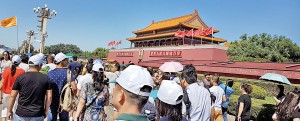
To Tiananmen with love: A large number of people from all parts of China visit the Square. For most, it's a dream-come-true visit.
Tiananmen Square is an economic indicator, said our tour guide as we discussed briefly the global concerns over China’s slowdown. We know economists use consumer price indices, stock market indices, gross domestic product and the strength of the local currency as indicators to judge the economic performance of a country, but a capital’s main square being used as an economic indicator is news to us.
Our tour guy, Mr. Rocky — that was what he wanted us to call him – has an answer. Mr. Rocky was a ten year-old boy when the Tiananmen Square protests for greater political freedom took place in 1989. He said he grew up with the change that transformed China’s economy from a centrally controlled state economy to the present social market economy.
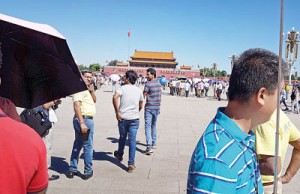
Mr Rocky, our tour guide, says the crowd at Tiananmen Square is an economic indicator
He said his economic barometer was the crowd strength at Tiananmen Square: The bigger the crowd, the stronger the economy. We were at Tiananmen Square on Sunday August 28 – hours after we arrived in Beijing on a ten-day tour organised by the Chinese embassy for 17 Sri Lankan journalists. The crowd at Tiananmen Square was so overwhelming that Mr. Rocky had to warn us not to lose sight of him. He carried a red flag attached to a long stick as he zigzagged through the hundreds of thousands of happy faces at the 440,500 square metre square – the size of about 30 cricket grounds. Just arrived in the country, we followed him, like a bunch of schoolchildren on an excursion. People came from all parts of China. The young and the old alike were seen taking pictures, with selfie sticks galore. Their looks indicated that they were economically well off, cultured and that they have surplus money to spend on travel, which is now made easy by the super-grade road networks and transport systems.
We learnt that China’s domestic tourism has been growing by ten percent for the past decade or so and it constitutes 4 percent of China’s GDP of 9 trillion dollars.If Chinese citizens have only one chance to visit a city in their life time, said Mr. Rocky, they would choose Beijing. If they were told that they could go to only one place in Beijing, he said they would select Tiananmen Square. Tiananmen in Chinese means the Gate of Heavenly Peace. Since the Communist revolution of 1949, the Gate, built in the 15th century during the Ming dynasty, has become the symbol of state power.
Communism is not dead
The Gate carries a portrait of Mao Zedong, who gave leadership to the people’s revolution in 1949. It opens the way to the Forbidden City that tells stories about not only the Ming Dynasty rulers who built it but also about China’s rise and fall, the dirty Opium Wars the Europeans foisted on the Chinese and the shenanigans surrounding China’s politics.
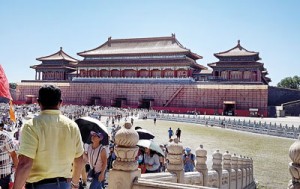
Through the Gates of Heavenly Peace to the Forbidden City
Apart from the Forbidden City, the square also houses the Great Hall of the People where China’s parliament or the National People’s Congress meets, the Monument to the People’s Heroes and the Mausoleum of Mao Zedong. We could feel the devotion with which thousands of people line up to pay their respects to Chairman Mao. The scene belies western media reports which tend to undermine Mao’s legacy and his revolution.
Communism is not dead in China. It is still visible in China’s economic success, the credit for which is usually given to Deng Xiaoping who took over the leadership after Mao’s death. But Deng’s reforms would not have succeeded if Mao had not prepared the people for it. He made them to labour in fields and factories, but in the end, they emerged as skilled.
Deng gradually and cautiously introduced free market principles into China’s state-controlled economy, keeping one leg on the accelerator and the other on the brakes. He guided China to what is now known among economists as social-market economy, a mix of socialist ideologies and pragmatic free-market concepts.
The blue and grey uniform like clothes the Chinese wore during the days of Mao have long since disappeared. Instead of the communist-era clothes that covered the curves of women, in modern China, the clothes many women wear are statements of fashion. The malls are full of international brands while on the roads, upmarket cars such as Mercedes Benz, Audis and BMWs – all made in China — are commonplace. Yet the Communist era’s commitment to hard work can be seen in the people as China is on the threshold of becoming the world’s number one economy.
How did China achieve this remarkable economic feat? During our visit to Haitian textile factory in Quanzhou (pronounced Chanzou), we found the answer. Deng’s reforms began in the agricultural sector and gradually extended to industry and the service sector. Infrastructure building, public utilities and the energy sectors were with the state.
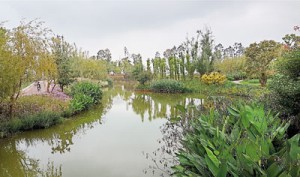
Picture postcard beauty: The Kunming's wetland park, a main component of Kunming's city-building project
When the reforms took root, it brought together Mao’s small entrepreneur, academic and the skilled worker. With the state providing financial assistance, the three clicked to form a venture. The Haitian textile factory which specialises in sports fashion under a number of international brands was one such combination. It was set up in 1994. Company officials told us they not only pay attention to quality, but also to research and development. That was the secret of the company’s success, they said. As the fledgling private sector thrived under Deng’s reforms, the country was also opened up for foreign direct investments. More sweeping reforms were introduced in 2005, opening up the infrastructure, public utilities and the energy sectors for private sector investment.
Privatisation strategy
In recent months, Sri Lanka’s Prime Minister Ranil Wickremesinghe has been reiterating at public meetings that Deng found Sri Lanka’s free trade zone model appealing and introduced it in China. While the model took China to the stars, Sri Lanka was plagued by a 30-year-war and corrupt politicians. But Sri Lanka can learn much from China’s experience, especially lessons in privatising state-enterprises. Under Deng’s reforms, small-scale state enterprises were privatised or closed; but large-scale ones were restructured. Some were merged and made into corporations and allowed to raise funds through the stock market. Unlike Sri Lankan state-sector workers who have become the pawns of their political masters masquerading as union leaders, China’s state-sector workers did not strike or accuse Deng of selling state resources. They knew it was the way forward and cooperated with Deng.
Among the state enterprises that were restructured were the state-owned China Harbour Engineering Company Group and the China Road and Bridge Group. They were merged to form China Communications Construction Company (CCCC).
China Harbour Engineering Co Ltd (CHEC), a subsidiary of CCCC, is today one of the biggest construction companies in the world. It built the Hambantota Port and has won the contract to build the International Financial Centre or the Port City in Colombo.
During our stay in China, whichever way we turned and wherever we went, we saw the construction of new roads, flyovers, skyscrapers and large-scale projects – a city-based economic strategy to develop. The people were happy to see their cities taking a new shape and were grateful to Mao’s groundwork and Deng’s reforms.
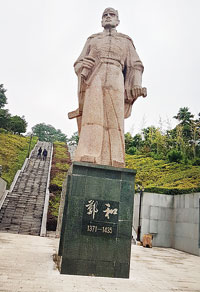
Zheng He: Kunming's connection to the ancient Maritime Silk Road
During our visit to Kunming, the city of eternal spring – its temperature averages 20 Celsius throughout the year — in the South West of the country, the city’s Foreign Affairs Office officials took us to two mega project sites. Kunming is the capital city of China’s Yunnan Province, which shares borders with Myanmar, Laos and Vietnam. This beautiful mountainous city some 1,892 metres above sea level is also the hometown of the famous Chinese Mariner Zheng He. We visited the Zheng He theme park and museum. In the first part of this article published last week, we said an imaginary silk thread that connected the ancient Maritime Silk Road and the modern Maritime Silk Road followed us wherever we went during our stay in China. The silk thread was visible at the Zheng He Park, where archaeological evidence was shown linking Sri Lanka and Zheng He, a hero of the ancient Maritime Silk Road. It was also visible at the sites of the two mega projects.
Green projects
The US$ 6 billion Kunming Financial Centre project site, reminded us of the Port City or Financial Centre project the Chinese will build in Sri Lanka. The project is part of Yunnan’s “gateway strategy,” with which it seeks to boost trade with South and Southeast Asian nations. We visited the Kunming Dianchi Convention Centre, a part of the project. The showpiece convention centre hosted the China-South Asia Expo in June this year. Sri Lanka, whose national carrier operates two flights a week to Kunming, sent a large trade delegation to the Kunming Expo. Similar expos are held to promote trade with South East Asian nations also, regardless of political differences over South China Sea disputes. The trade shows appear to underscore China’s policy of promoting peace through trade.
We were also taken to the Kunming Dianchi International City Wetland Park Project that was being built around the wetlands and the Dianchi Lake. The economy of Yunnan and its capital city Kunming thrives on tourism. The US$ 12 billion project includes a Disneyland-like theme park, high-rise apartment complexes, business districts and shopping malls and is aimed at achieving higher living standards for its citizens and a faster economic growth for the city.
The mega projects, we were told, were environment friendly. City officials told us that they were committed to the cause of protecting the environment. They said eighty percent of the city’s energy needs were met by green energy sources such as solar power, wind power and hydro power. Wetland Park project officials said the project was a combination of the area’s ecological contribution – its topography, greenery and hydrological resources — and the development needs of the city.
Riding an open electric cart, we enjoyed the beauty of the park. It was certainly a delight to the eye and a statement that spoke about China’s city-building capabilities. Figures may show that China’s economy has slowed down, but the ground reality indicates there is more room for growth in Social-Market China. The Communist Party seems to know when to step on the accelerator and where to press the brakes.
(More next week)

